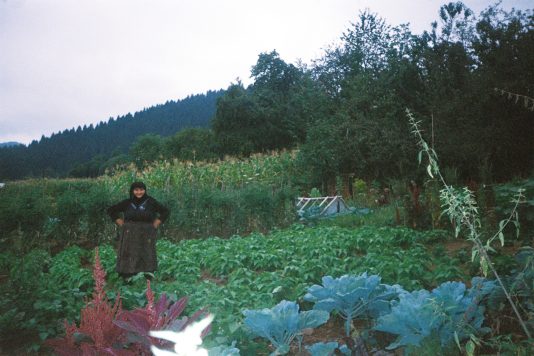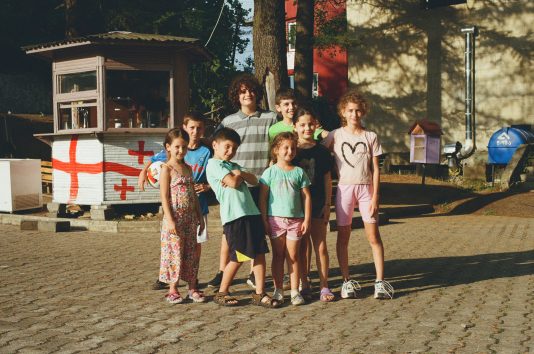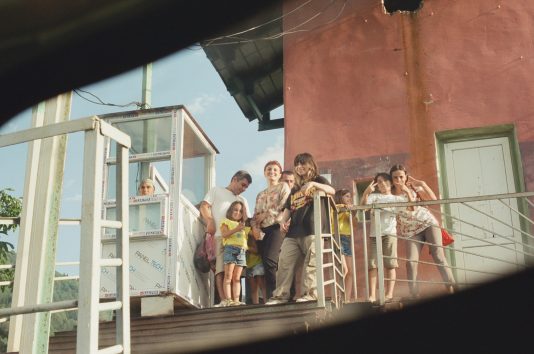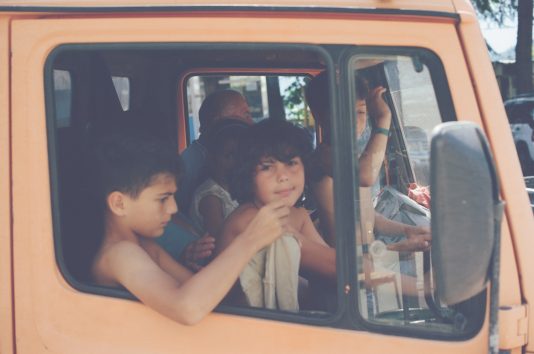Title: Meeting Point: Mountains
Location: Adjara, Georgia
Community: Local population
Artists:
Nestan Abdushelishvili (Photographer – Georgia)
Sandro Sulaberidze (Photographer – Georgia)
Nini Khuroshvili (artist/researcher – Georgia)
Giorgi Shengelia (Photographer – Georgia)
Davis Kanepe (artist, director – Latvia)
Curator: Ana Gabelaia (Georgia)
For the second year of the Magic Carpets residency programme, the Tbilisi Photo Festival decided to journey to southwestern Georgia – Adjara. Adjara lies on the coast of the Black Sea near the foot of the Lesser Caucasus Mountains, north of Turkey. This region, still bearing the name of the Autonomous Republic of Adjara, has a turbulent history that left an indelible mark, as its inhabitants remain among the most isolated groups in Georgia. One reason for this is the poor infrastructure – the roads are challenging to navigate, and in the cold winters, they are often impassable. Another reason is the aforementioned history and the religious identity of the community – two centuries of Ottoman occupation led to the Muslimization of the entire population. Later, during the Soviet occupation, this fact was exploited to keep the Adjarian people under constant pressure. Unfortunately, this continued even after the collapse of the Soviet Union. Nowadays, 40% of the population remains Muslim. Upper Adjara is home to some of the most beautiful and ancient mosques in the country. At first glance, observing orthodox Christians and Muslims living side by side might suggest no lingering issues, but past discrimination has left an invisible barrier between Adjarians and the rest of Georgia.
Armed with this information, we endeavoured to delve deeper into the lives of the local Adjarian people, to forge a closer connection and gain a better understanding of their needs, beliefs, culture, and daily existence. As always, we chose art as our medium, and within the framework of the Magic Carpets program – designed to connect artists with diverse communities – we dispatched local and international artists as ambassadors to the region.
Five artists participated in the residency program, each stationed in different parts of Adjara, exploring diverse themes with communities ranging from the lowest part of Mountainous Adjara to the highest point.
Nestan Abdushelishvili, a photographer from Tbilisi, opted to venture to the Keda municipality.
During her stay in the village of Vaio, with the assistance of local community members, Nestan explored nearby villages, visiting families, schools, and cultural centres; engaging with tobacco farmers, winemakers, and other agricultural workers on-site. However, what captivated her most were the local museums. When we evoke the term ‘museum,’ a specific image forms in our minds, but the small-town museums in Adjara differ significantly from our preconceptions. Operated largely on local enthusiasm due to the absence of professional assistance and government funding, these museums safeguard the region’s heritage, including objects of great historical significance. ‘How they preserve and present all of this to the viewers, without any institutional benefits, is almost surreal,’ Nestan says. Enthralled by this community spirit, Nestan chose to make local museums her primary research focus, with their curators becoming the community she would collaborate with. While moving from one museum to another, she conducted interviews and documented collections, including numerous objects depicting the life of the region and old photo archives. Her work held immense value for the local community, especially considering the unpredictable fate of these small museums.
As an institution primarily focused on photography and visual imagery, we were intrigued by the photo archives in mountainous Adjara, encompassing family albums, photo studio records, and more. When we shared this idea with Sandro Sulaberidze (Photographer, Tbilisi, Georgia), he agreed to embark on a research trip to Ghorjomi Valley, located in Khulo, the highest municipality of Adjara. Here, the population is predominantly Muslim, and religion remains the centrepiece around which everything revolves. This initially posed challenges for Sandro to integrate into the community, but forming connections with local children eventually opened doors to numerous households.
As revealed by Sandro’s research, in the highlands of Adjara, photographic memory is preserved only with the living. The community holds a unique attitude towards images influenced by their faith. According to their belief, looking at pictures of a deceased person harms their soul and causes suffering in the afterlife. Consequently, family members either hide or burn all photographs after the death of a loved one. In the mountains of Adjara, photographic and documentary memory exists only during a human’s lifetime. Over time, family photo albums vanish, and memories yield to personal feelings, emotions, and stories. Thus, while searching for old photo archives, Sandro uncovered poignant and personal stories of individuals and their departed loved ones. What was initially intended as documentation of archival images transformed into a collection of audio tales.
Nini Khuroshvili (artist/researcher – Tbilisi, Georgia) was the second artist to travel to Ghorjomi Valley. Given the community’s reputation for a robust self-organising system, Nini was particularly interested in understanding their methods of self-organisation. Additionally, being known as the most conservative Muslim community in comparison to surrounding villages, which still adheres to strict rules, Nini aimed to explore gender roles and the power of women in decision-making.
With these intentions, she spent three weeks immersing herself in the community, visiting households, asking questions, and gradually gaining more answers as she became familiar with the community members. Eventually, Nini chose to concentrate on the stories of local women, as they left the most lasting impression on her. She met women representing three different generations, living in four villages of the valley. The audio interviews Nini recorded, the portraits she captured, and the visual material depicting their life in the village narrate the inspiring story of these women.
Giorgi Shengelia (Photographer, Georgia) dedicated his residency to Vaio, Keda region. Following his initial visit, he immediately knew that a return trip was necessary. Ultimately, he visited the village thrice and is planning another excursion in winter to sustain connections even after the project concludes. Giorgi documented the daily life of the small village throughout different seasons, exploring the family connections and the communal spirit that makes the entire village feel like one extended family. Surrounded by layers of mountains, he strolled from one end of the village to another, meeting people along the way. Soon after his arrival, everyone in the village knew about the visiting photographer, so even those he had never encountered before recognised him, allowing him to capture photographs and inviting him into their homes. As a result of his residency, Giorgi crafted a visual narrative of the quaint village of Vaio and the people who render the place enchanting.
Davis Kanepe, an international guest artist in residency, was immediately intrigued by the prospect of visiting the village of Tago upon hearing about its distinctive feature – it is situated atop a mountain, just across the river from Khulo, the regional centre of upper Adjara. A metal wire connects these two mountains, with a small red cable car gliding along it daily from morning till sundown. Despite an alternative road to Tago, the cable car remains the primary means of transportation to and from the village.
Establishing the base camp in Tago, Davis explored extensively and visited the highest points of the region, where people from Adjara, scattered throughout the entire country, gather in August to celebrate togetherness. While traversing roads under construction or heavily damaged, and keeping in mind the red cable car that he figuratively called the ‘magic carpet,’ Davis contemplated the significance of roads, the possibilities they open up for remote communities, and what they may demand in return. His photo series captures life in Tago, a small remote village soon to be transformed into a tourist destination, where the cable car will evolve from local transport to a point of attraction.
In the end, ‘Meeting point: Mountains’ not only created a literal meeting point in Mountainous Adjara for people – artists, curators, and community members – who might never have crossed paths otherwise, but it also proved to be a profound experience. These encounters revealed new horizons and laid the foundation for enduring relationships.
Curatorial text by Ana Gabelaia


































